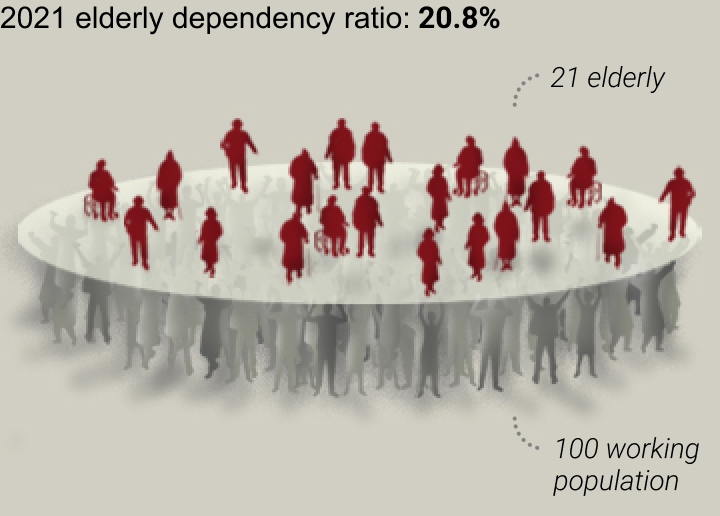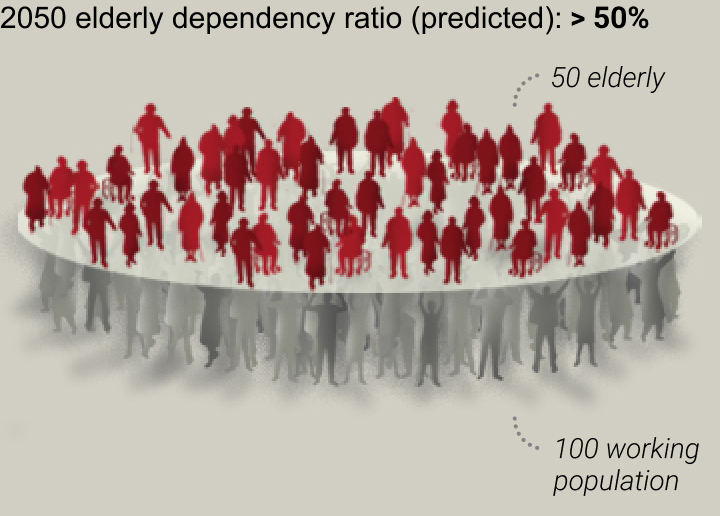For family and country: why China needs more babies
China, an economic powerhouse of 1.4118 billion people, is facing a demographic dilemma. China’s population is shrinking and ageing, and its gender balance is skewed with more men than women. Together, they present unique and complex challenges for the world’s second-largest economy. This visual explainer explores the causes and consequences of China’s population problems, and some of the solutions proposed.
China’s population since 1949
Evolution of the population
figures since 1949
China’s population shrinks
China recorded its first population drop in six decades in 2022, and in 2023, it is reported to have lost the title of “world’s most populous country” to India. By 2050, China’s population is expected to fall to around 1.32 billion, while India’s will have hit 1.67 billion, according to the United Nations. Since the 1990s, China’s fertility rate (total number of children that would be born to each woman) has fallen below the replacement level of 2.1. This means that there are not enough births to replace the deaths in the population. A major reason for low fertility is the legacy of China’s one-child policy. High child-rearing costs, shifting ideologies on family and marriages, as well as the slowing economic growth have all been blamed for the population decline.
One-child policy
China’s one-child policy was rolled out in 1980 by Deng Xiaoping and was strictly enforced after the population had increased to 987 million that year from around 550 million in 1949. It restricted most couples to only a single child, and for years authorities argued it was a key factor in supporting the country’s economic boom.
But the policy led to sex-selective abortions or infanticide targeting girls, because of a centuries-old social preference for boys. According to recent census data, China has almost 35 million more males than females.
In recent years, encouraging couples to have more children has been high on Beijing’s agenda. In 2016, China ended its one-child policy and allowed all couples to have two children. In 2021, China further relaxed its family-planning policies and allowed couples to have three children.
Raising children
A high cost of living and gruelling work hours have been cited as reasons for young Chinese thinking twice about having any children, let alone more than one. Chinese research found that in 2019, it cost 485,000 yuan (US$67,803) to raise a first child from birth to 17 years old in China, which was nearly seven times the per capita GDP that year. The expenses were even higher in China’s big cities, with Shanghai exceeding 1 million yuan and Beijing reaching 969,000 yuan. The two cities also had birth rates that were lower than the national level.
China’s ageing population
China has one of the fastest growing ageing populations in the world, with the proportion of people over 60 years old projected to reach 28 per cent by 2040, according to the World Health Organization. This is expected to weigh on the world’s second-largest economy in the coming decades, while placing pressure on China’s health and social security system.
Chinese officials and demographers have called for a return to traditional Chinese family values to tackle a looming demographic crisis.
Age dependency ratio
The old-age dependency ratio is a measurement that compares the number of people aged 65 and above with those of working age - between 16 and 59 years old.
According to the Seventh National Chinese Population Census, the age dependency ratio in China increased to 46.3 per cent in 2021. It means that for every 100 people of working age, more than 46 elderly people and children had to be supported. When only looking at elderly data, the dependency ratio was 20.8 per cent. This was expected to exceed 50 per cent by 2050, according to a 2023 report by Chinese economist Ren Zeping.
The UN has forecast that the total dependency ratio could exceed 75 per cent by 2055 – much higher than the estimated global average.


China’s demographic dividend
China’s workforce continues to fall by millions each year, chipping away at the nation’s “demographic dividend” - a term that refers to economic growth resulting from the age structure of a nation’s population.
China’s working-age population – those between 16 and 59 years old – stood at 875.56 million at the end of 2022, representing 62 per cent of the population, but this was down from 62.5 per cent a year earlier.
Amid growing market concerns about a shift of demographic dividend to India - now reported to be the world’s most populous country - Chinese officials have sought to play up China’s strengthening “talent dividend”. There are challenges due to a mismatch between the talent being cultivated and what the market needs.
China net migration
Since 1950, China has had a net negative number of migrants, meaning more people leave the country than arrive. According to the World Bank, there was an estimated net out-migration of 311,380 people in 2022, up from 200,194 in 2021, and 33,640 at the start of the Covid-19 pandemic in 2020 when many international borders were closed. Today’s figures are much lower than 1990-93 when over 750,000 of China’s citizens moved abroad each of those years.
What are China’s solutions?
Three-child policy
To deal with the challenges of an ageing population, Beijing in 2021 announced that couples can have up to three children. The policy shift followed a major change in 2016, when Beijing ended the decades-old one-child policy, allowing couples to have two children.
Cash incentives
Many local governments have issued cash incentives and other preferential policies. Couples in Shenzhen who have a third child will be eligible for a cash allowance of 19,000 yuan (US$2,800) until the child turns three years old. Jinan, a city in Shandong province, is offering childcare subsidies and increasing parental leave. In July 2021, Panzhihua in Sichuan province became the first city in China to offer subsidies to help families raise more children – a monthly allowance of 500 yuan per second or third child up to the age of three.
Cutting marriage red tape
Many of China’s migrant workers will no longer have to travel back to their hometowns to get married under new rules. In 2023, the State Council, China’s cabinet, approved a regulation allowing people from 21 provinces and municipalities – mostly in eastern and central China such as Beijing, Shanghai, Guangdong and Zhejiang – to register their marriage where their residence permits were issued. Previously, a prospective bride and groom had to return to the city or country of their hukou, or household registration, to register for marriage.
Raising retirement ages
China in 2022 confirmed that it would delay retirement ages – 60 for men, 55 for female office workers, and 50 for female blue-collar workers – from 2025.
Legalising births outside marriage
In Sichuan province, unmarried individuals will now be allowed to register the birth of their children, whereas previously only married women were legally permitted to do so.
Reducing abortions
China’s family-planning agency says it will “intervene” when unmarried women and teenagers seek abortions, and will promote traditional values to encourage people to have more children.
Associate Creative Director Marcelo Duhalde
Edited by Andrew London, Andrew Mullen
Additional research and design by
Marcelo Duhalde, Mandy Zuo
Cover illustration by Brian Wang
Sources: YuWa Population Research Institute, United Nations, The World Bank, National Bureau of Statistics of China, Xinhua, National Health Commision of China

